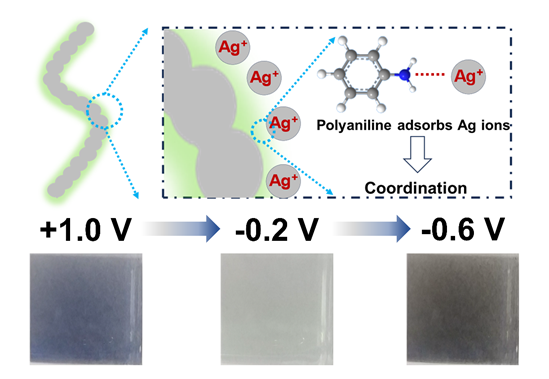| [1] |
Peng H. C.; Pan M. F.; Jiang H.; Huang W. H.; Wang X.; Yang Q.; Chen S.; Yan B. ACS Appl. Mater. Interfaces 2022, 14, 42402.
|
| [2] |
Lei P. Y.; Wang J. H.; Gao Y.; Hu C. Y.; Zhang S. Y.; Tong X. R.; Wang Z. P.; Gao Y. H.; Cai G. F. Nano-Micro Letters 2023, 15, 34.
|
| [3] |
Chen Y. N.; Lei J.; Zhai Y. L.; Zhu Z. J.; Wu W. T.; Lu X. Q. Chin. Chem. Lett. 2023, 34, 108305.
|
| [4] |
Wang C. C.; Jiang X. J.; Cui P.; Sheng M. F.; Gong X. D.; Zhang L. P.; Fu S. H. ACS Appl. Mater. Interfaces 2021, 13, 12313.
|
| [5] |
Li R.; Ma X. Y.; Li J. M.; Cao J.; Gao H. Z.; Li T. S.; Zhang X. Y.; Wang L. C.; Zhang Q. H.; Wang G.; Hou C. Y.; Li Y. G.; Palacios T.; Lin Y. X.; Wang H. Z.; Ling X. Nat. Commun. 2021, 12, 1587.
|
| [6] |
Xu J. W.; Zhang Y.; Zhai T. T.; Kuang Z. Y.; Li J.; Wang Y. M.; Gao Z. D.; Song Y. Y.; Xia X. H. ACS Nano 2018, 12, 6895.
|
| [7] |
Yang L. L.; Feng J. J.; Wang J. N.; Gao Z. D.; Xu J. W.; Mei Y.; Song Y. Y. Chin. Chem. Lett. 2022, 33, 5169.
|
| [8] |
Kandpal S.; Ghosh T.; Rani C.; Chaudhary A.; Park J.; Lee P. S.; Kumar R. ACS Energy Lett. 2023, 8, 1870.
|
| [9] |
Qin M. M.; Li X.; Zheng Y. P.; Zhang Y.; Li C. J. Acta Chim. Sinica 2015, 73, 1161 (in Chinese).
|
|
(秦咪咪, 李昕, 郑一平, 张焱, 李从举, 化学学报, 2015, 73, 1161.)
doi: 10.6023/A15070505
|
| [10] |
Tu L. L.; Jia C. Y.; Weng X. L.; Deng L. J. Acta Chim. Sinica 2010, 68, 2590 (in Chinese).
|
|
(涂亮亮, 贾春阳, 翁小龙, 邓龙江, 化学学报, 2010, 68, 2590.)
|
| [11] |
Cai G. F.; Tu J. P.; Zhou D.; Zhang J. H.; Wang X. L.; Gu C. D. Sol. Energy Mater. Sol. Cells 2014, 122, 51.
|
| [12] |
Xiong S. X.; Phua S. L.; Dunn B. S.; Ma J.; Lu X. H. Chem. Mater. 2010, 22, 255.
|
| [13] |
Zhou K. L.; Wang H.; Jiu J. T.; Liu J. B.; Yan H.; Suganuma K. Chem. Eng. J. 2018, 345, 290.
|
| [14] |
Onodera R.; Tsuboi A.; Nakamura K.; Kobayashi N. J. Soc. Inf. Display 2016, 24, 424.
|
| [15] |
Araki S.; Nakamura K.; Kobayashi K.; Tsuboi A.; Kobayashi N. Adv. Mater. 2012, 24, OP122.
|
| [16] |
Tsuboi A.; Nakamura K.; Kobayashi N. Adv. Mater. 2013, 25, 3197.
|
| [17] |
Peng H. C.; Jiang H.; Tu S. J.; Zhang S. H.; Ren E. H.; Yan B.; Yang Q.; Chen S. Opt. Lett. 2020, 45, 2443.
|
| [18] |
Xiong C. Y.; Zhang Y. K.; Xu J. Y.; Dang W. H.; Sun X. H.; An M.; Ni Y. H.; Mao J. J. Nano Research 2023, 16, 9471.
|
| [19] |
Niu B.; Li Z. A.; Luo D.; Ma X. Y.; Yang Q. S.; Liu Y. E.; Yu X. Y.; He X. R.; Qiao Y.; Wang X. Energ. Environ. Sci. 2023, 16, 1662.
|
| [20] |
Hu B.; Xu J.; Fan Z. J.; Xu C.; Han S. C.; Zhang J. X.; Ma L. B.; Ding B.; Zhuang Z. C.; Kang Q.; Zhang X. G. Adv. Energy Mater. 2023, 13, 2203540.
|
| [21] |
He Z. W.; Lü Q. F.; Zhang J. Y. ACS Appl. Mater. Interfaces 2012, 4, 369.
|
| [22] |
Yang S. W.; Zheng J. M.; Wu X. M.; Xu C. Y. Acta Chim. Sinica 2013, 71, 1041 (in Chinese).
|
|
(杨树威, 郑建明, 吴星明, 徐春叶, 化学学报, 2013, 71, 1041.)
doi: 10.6023/A13020168
|
| [23] |
Chen Z. J.; Shen T. Y.; Zhang M. H.; Xiao X.; Wang H. Q.; Lu Q. R.; Luo Y. L.; Jin Z.; Li C. H. Adv. Funct. Mater. 2024, 35, 2211673.
|
| [24] |
Zhao L.; Li Y.; Yu M. M.; Peng Y. Y.; Ran F. Adv. Sci. 2023, 10, 2300283.
|
| [25] |
Zhou Y.; Wang S. C.; Peng J. Q.; Tan Y. T.; Li C. C.; Boey F. Y. C.; Long Y. Joule 2020, 4, 2458.
|
| [26] |
Peng H. C.; Yan B.; Jiang M. J.; Liu B. C.; Gu Y. C.; Yao G.; Zhang Y.; Ye L. L.; Bai X.; Chen S. J. Mater. Chem. A 2021, 9, 1669.
|
 )
)
